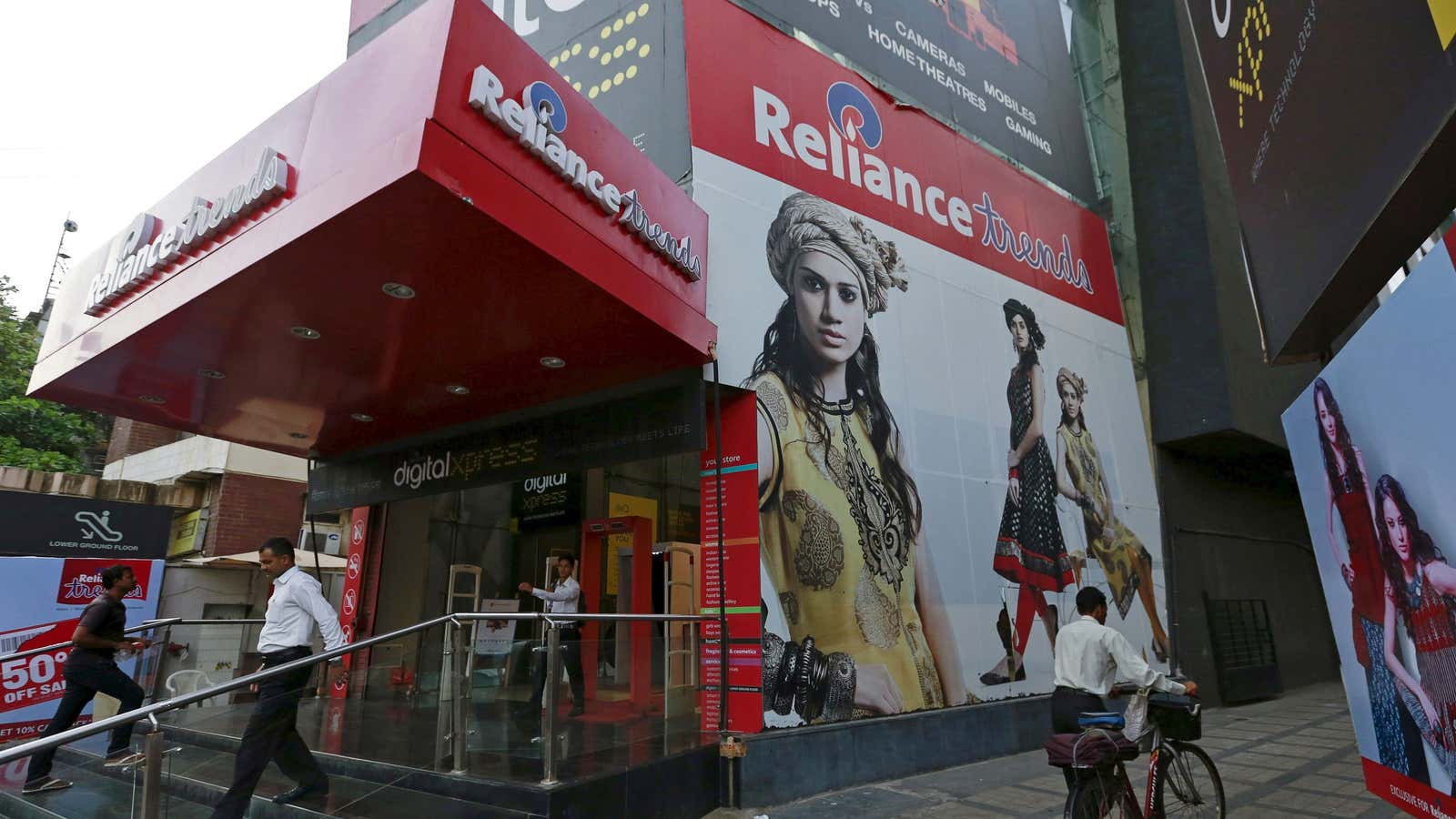India’s richest man just can’t help being disruptive.
After ushering in a crackling internet data-usage boom in the country, Reliance Industries Limited (RIL) chief Mukesh Ambani plans to transform its already rising e-commerce industry, till now a bastion of the two American retailing rivals Amazon and Walmart.
On Jan. 18, Ambani said two of his group companies, Reliance Retail and Reliance Jio Infocomm, will together launch a new e-commerce portal that will benefit nearly 1.2 million small retailers and shopkeepers in the western Indian state of Gujarat alone. Ambani was speaking at the state’s flagship annual event, the Vibrant Gujarat summit.
Given RIL’s history, most recently in the telecom space, experts believe Ambani is a rival that incumbents need to seriously watch out for.
“Reliance has had an Indian presence for many years and, therefore, understands the on-ground realities, especially of small- and mid-sized shopkeepers. Moreover, it is a company that knows how to launch businesses and scale them,” said Yugal Joshi, vice-president of Texas-based consultancy Everest Group.
However, the oil-to-telecom conglomerate will not be immune to the incumbents’ challenges. Besides, the group is “yet to prove its success outside of traditional business models of oil and telecom,” Joshi said.
Ambani’s e-commerce ambitions
While the Ambani-led group has not yet shared any further details on what its new e-commerce venture would look like, the business will definitely have a giant scale given Reliance Retail and Reliance Jio Infocomm’s current reach, and Ambani’s deep pockets.
Reliance Retail currently has nearly 10,000 stores in over 6,500 towns. And within less than three years of its launch, Jio already boasts of a subscriber base of 280 million users in India.
Reliance’s e-commerce venture’s “success could be built on an ecosystem or bundling strategy, and a home court advantage, similar to Alibaba’s success in China, beyond explicit or implicit policy support,” brokerage firm UBS said in a note on Jan. 24.
In addition, the untapped opportunity in the e-commerce segment is big considering the low internet penetration in India. While the country is home to the world’s second-largest internet user base, e-commerce is not as popular here as in the US or China. In fact, in 2018, e-commerce accounted for under 3% of India’s overall retail sales.
Besides the merits of its retail and telecom arms, Reliance is a far more popular brand name in India than its American rivals, making it a more likely candidate to attract first-time shoppers.
Right time, right place
Reliance could not have found a better time to launch its e-commerce business.
Late last year, the Narendra Modi government announced several restrictive changes in its foreign direct investment (FDI) policy for online retailers, which was first floated in 2016. These changes could potentially force retailers to change their business models.
Among other things, starting Feb. 01, online marketplaces are barred from entering into exclusive deals for selling products on their platforms. Additionally, no more than 25% of the inventory on an e-commerce platform can be from a single vendor.
So far, online retail in India has grown mostly on the back of deep discounts. With the government capping discounts, the incumbents may now struggle to even retain existing customers.
“Indian customers are by nature bargain-hunters so that is not changing anytime soon,” said Ankur Nigam, partner, transaction advisory services, at consultancy EY. “Also, most of the customers that any online portal has today are overlapping. They (online platforms) are all going to be chasing the same set of customers.
The existing e-commerce companies are currently struggling to meet the new norms. Sector leaders, Walmart-owned Flipkart and Amazon, have already requested the government to grant them additional time to meet these guidelines.
But there’s struggle
Funding, which has so far fueled e-commerce firms in India, is not an issue for either of the three main contenders, Amazon, Walmart, and Reliance.
However, each lags in particular areas while claiming strength in others, according to multiple experts Quartz spoke to. For instance, Walmart has a strong understanding of the supply chain, sourcing, and consumers; Amazon is the frontrunner when it comes to technology, and Reliance understands India and the Indian consumer best and has robust political connections.
Although Reliance’s offline retail game has been strong, “replicating success in the e-commerce world will take some sharp learning and a lot of spending,” said Vidhya Shankar, executive director at advisory firm Grant Thornton.
Paralleling or beating Amazon’s repeat customer count won’t come easy. Neither will it be simple to take a bite of India’s $53 billion business-to-business e-commerce pie, where Flipkart eclipses even Amazon.
“…we’ve seen large Indian business houses get into the e-commerce fray before and burn their fingers. I think the big reason for that is the DNA,” said EY’s Nigam. “Most companies in India, as well as overseas (Walmart included), are great at running brick and mortar businesses. What they lack is the DNA to run a digital platform.” The fix is to “pick up outstanding talent from the digital world and combine that with the great business acumen that they have in building large profitable businesses.”
